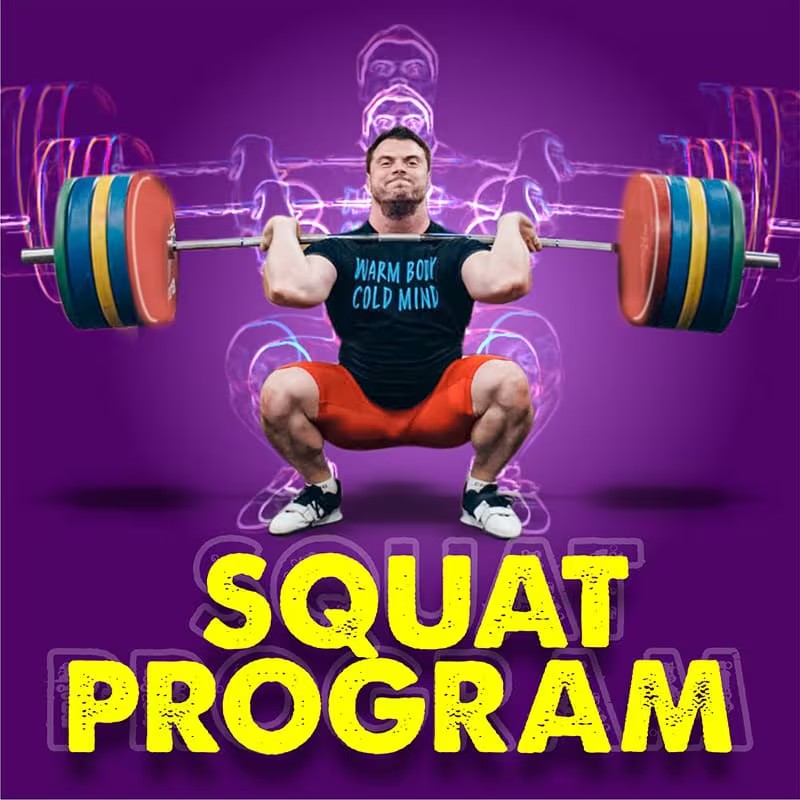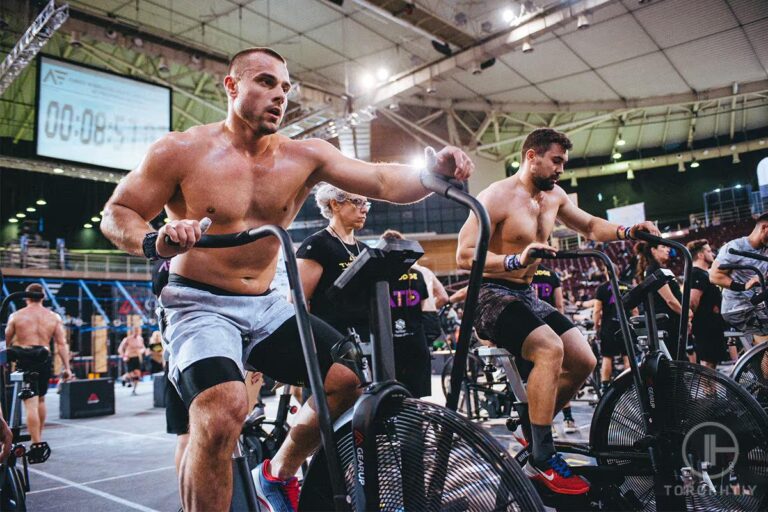Leg Exercises For Bad Knees: Strengthening Your Legs Safely
About 25% of adults experience knee pain. Over the past 20 years, there has been an over 65% increase in the prevalence of knee pain, accounting for almost 4 million visits to primary care each year.
Knee pain when exercising can be an unwelcome obstacle on your path to fitness, but don’t worry, it doesn’t have to cause you to give up. There is a way forward that enables you to strengthen your leg strength without causing more agony, regardless of whether you struggle with the lingering discomfort of arthritis, carry the legacy of prior injuries, or deal with a general sensation of unease in your knees.
This article reviews some top leg exercises for bad knees to improve your knee’s health and strength.
Knee pain shouldn’t stop you from working on your leg strength. Discover practical leg exercises for bad knees and expert tips on improving your knees and preventing pain during workouts.
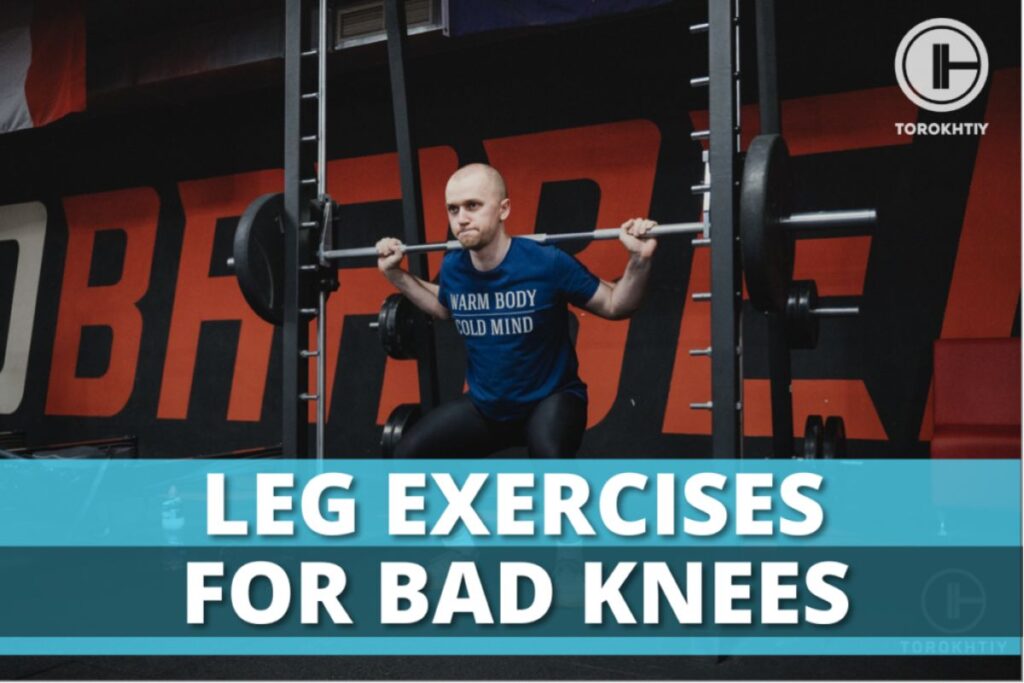
Anatomy of the Knee: The Complex Joint at the Heart of Leg Health
The knee greatly influences our mobility and leg strength. The knee consists of three bones: the patella (kneecap), femur (thigh bone), and tibia (shin bone). Ligaments, tendons, and muscles surround the knee to improve the stability and power of this joint.
The main muscles that control the mobility of the knee are the quadriceps in the front of the thigh, innervated by the Femoral nerve, and the hamstring in the back of the thigh, innervated by the Sciatic Nerve. Two menisci discs, each with a crescent shape, are located inside the joint and serve as shock absorbers to lessen the impact of movement.
The joint is nourished and lubricated by synovial fluid, enabling smooth movement. Understanding the knee’s anatomy is essential when crafting leg exercises for bad knees, as it empowers individuals to strengthen the surrounding muscles while minimizing strain on this vital joint.
🔻12 Week Squat Program by Oleksiy Torokhtiy
Do you want to double your squat strength? In just 12 weeks, you’ll be able to boost your squat results.
This program transforms any ordinary squat into a powerful athletic movement.
What’s included:
- 12 weeks of squat programming;
- Effective combination of sets, reps, and weights;
- Fully designed and coached by Oleksiy Torokhtiy;
- Over 60+ movements, banded work, and weight training;
- Accessory work for core, joint stability and injury prevention;
- Max out on back squat and front squat at the end.
Start now and boost your squat results!
What Causes Knee Pain during Exercising?
Before we discuss some of the best leg strengthening exercises for bad knees, it’s vital to comprehend the underlying causes to manage and relieve this discomfort effectively. The following are some typical causes of knee pain during exercise:
1. Overuse
A common factor in knee pain that occurs after exercise. Overuse injuries happen with a lack of proper progression: when people push their bodies over their present fitness levels or partake in repetitive, high-impact activities without giving them enough time to recover. The knee joint can become prone to injuries and pain with increased stress.
Overuse injuries are often noticed or seen in athletes or fitness enthusiasts who boost their training volume too rapidly or don’t take recovery days. The persistent stress imposed on the knee joint eventually takes its toll, resulting in pain, inflammation, and decreased performance. Overuse can lead to disorders like patellofemoral pain syndrome (PFPS) or tendinopathies.
2. Lack of Conditioning
On the other hand, weak muscles or a lack of conditioning can make exercising painful for the knees. Insufficient knee strength and stability can increase the unnecessary tension and pressure in your knees, creating pain. Due to this, the knee may be more vulnerable to sprains, strains, and tears.
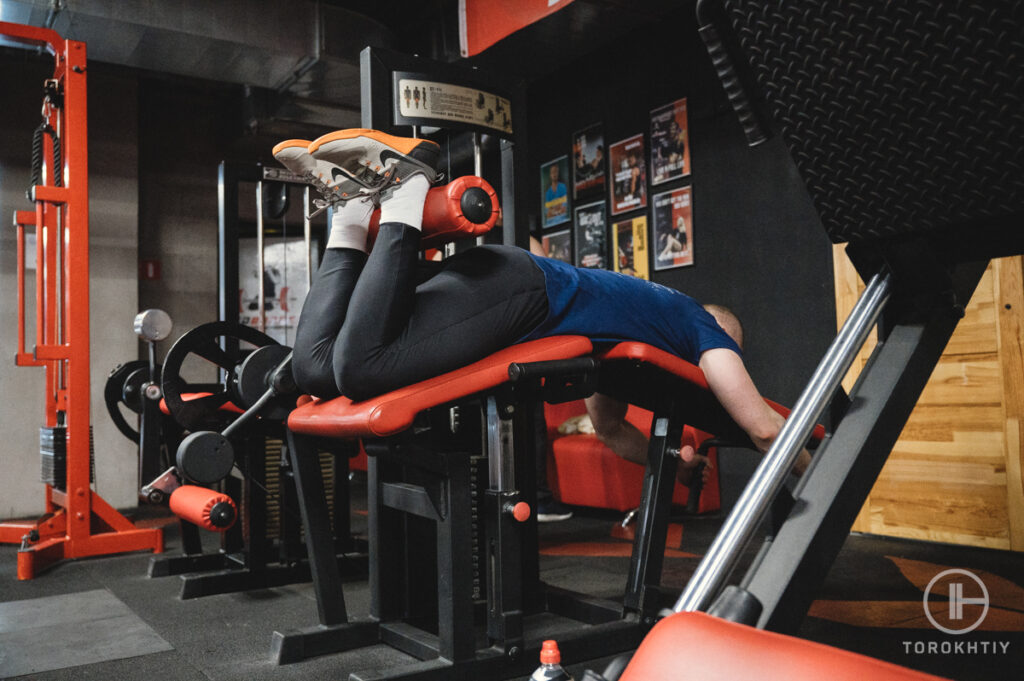
3. Current or Past Injuries
Knee pain while exercising is often caused by an injury to the knee joint or its surrounding structures, whether it is recent or old. Tendinopathies, sprains, and strains are common injuries that can lead to pain, inflammation, and reduced joint stability. More severe issues, such as ligament or meniscus tears, induced pain by decreasing strength production and stability of the knee during exercises.
Even after an injury seems to have healed, the knee may still be weak, making it prone to recurring soreness and injuries during physical activity. Ongoing discomfort could worsened by scar tissue or faulty joint biomechanics.
People with a history of knee injuries need to exercise extra caution, choose movements and exercises that put the least stress on the injured area, and talk to a doctor or physical therapist to ensure they follow the proper rehabilitation and prevention plans.
Types of Knee Pain & Injuries
1. Osteoarthritis
The most prevalent kind of arthritis, knee osteoarthritis, will become more commonplace as life expectancy and obesity increase. Approximately 13% of women and 10% of men aged 60 and above have symptomatic knee osteoarthritis, depending on the source. The frequency increases to 40% among people over the age of 70.
This degenerative joint disease is a leading cause of knee pain during movement. Osteoarthritis occurs when the protective cartilage that cushions the ends of your bones wears down over time. As a result, the bones in your knee can rub against each other, causing pain, stiffness, and reduced flexibility.
Even simple activities like walking or climbing stairs can become painful challenges for individuals with osteoarthritis.
2. Tendinopathies
Another prevalent cause of knee pain is tendinopathies, which involve the inflammation of tendons around the knee joint. Tendons are muscular, fibrous tissues that connect muscles to bones. When they become inflamed, it can lead to pain and discomfort during exercise.
High-impact activities or unexpected increased loading are common factors that can strain the tendons around the knee, leading to tendinopathies. Leg workouts can be challenging with this condition because of the increased pain.
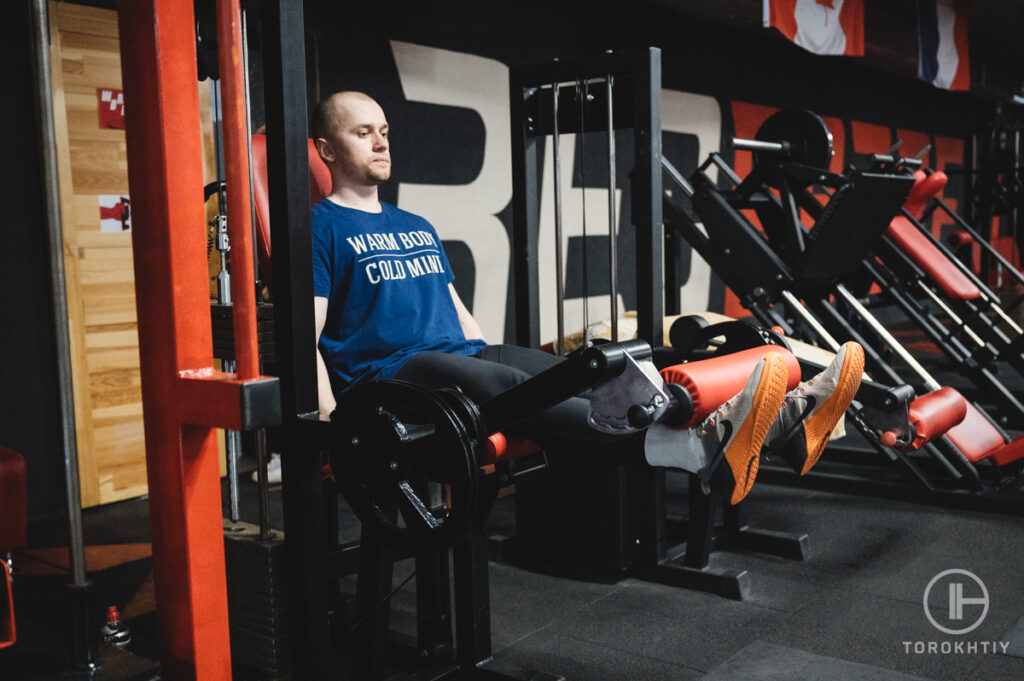
3. Meniscus Injuries
This cartilage-like structure acts as a shock absorber in the knee joint, cushioning and stabilizing your knee movements. The meniscus tears can cause significant knee pain, especially during activities involving compression, twisting, or sudden direction changes.
Meniscus tears often result from sports-related injuries but can also occur due to degeneration over time. Meniscal tears are approximately 61 cases per 100,000 people, with a 12-14% prevalence.
4. Patellofemoral Pain Syndrome (PFPS)
PFPS, commonly known as a runner’s knee, is characterized by pain around or under the kneecap. Mainly, it affects adolescents and adults younger than 60 years. Overuse or incorrect patella (kneecap) tracking inside the femoral groove frequently causes this disease.
Running, squatting, or climbing stairs can cause the patella to move awkwardly, which can cause pain and irritation. People who prefer high-impact exercises may have PFPS more severely.
5. Strains and Sprains
Knee strains and sprains are common injuries that can lead to significant knee pain and discomfort during exercise. These injuries involve damage to the ligaments and tendons, which are rugged bands of connective tissue that provide stability to the knee joint. A muscle or tendon strain happens when it is stretched or ripped, most frequently in the quadriceps or hamstrings.
Conversely, a sprain refers to injury to a ligament, such as the medial collateral ligament (MCL) or anterior cruciate ligament (ACL). Running, jumping, or other athletic actions can cause strains and sprains due to rapid, forceful movements or excessive knee twisting.
These injuries can range in severity from moderate strains or sprains that only cause minor discomfort to more severe cases that can cause pain, edema, and restricted movement.
Expert Advice: Understanding the specific cause of your knee pain is vital for effectively tailoring your exercise routine and treatment plan. Proper diagnosis and treatment involve seeing a medical professional like a physical therapist. They are crucial for healing and preventing long-term complications associated with these injuries.
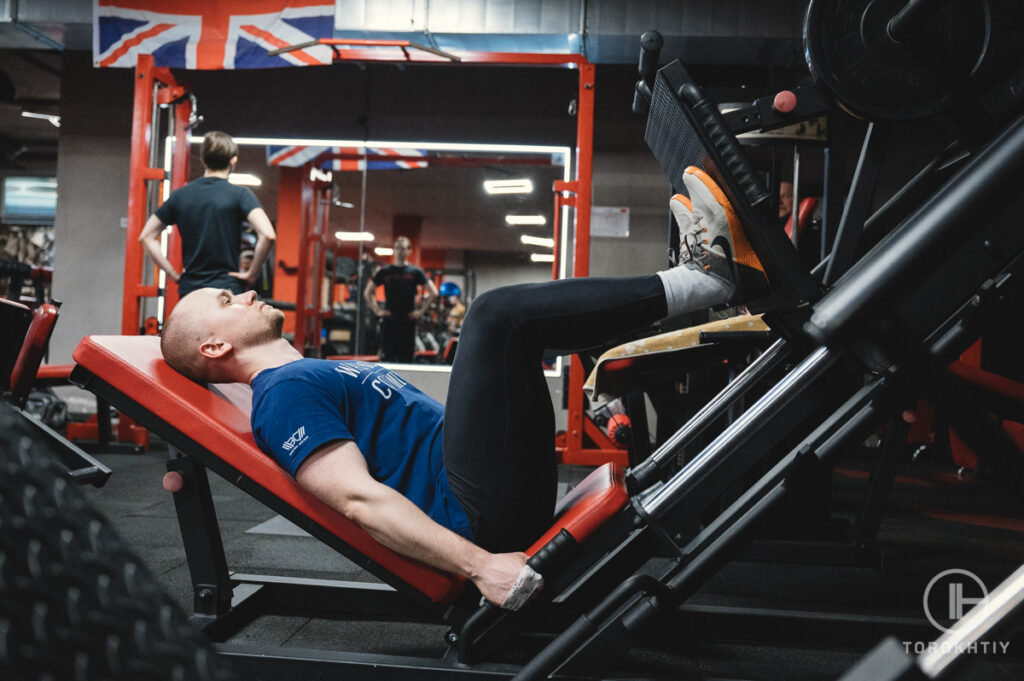
The Importance of Isometric and Eccentric Exercises for “Bad Knees”
Incorporating isometric and eccentric exercise routines for your leg workouts for knee pain is crucial for diminishing symptoms and enhancing leg strength, especially for individuals. If you have severe knee problems, it’s essential to do exercises that target leg muscles isometrically, such as wall sits, because they don’t put too much stress on the knee joint.
Additionally, exercises focusing on controlled muscle lengthening, such as seated leg lifts and resistance band leg presses, can improve stability and balance at the knee joint. These exercises can help reduce pain, improve knee health, and lower the likelihood of further injuries. It’s essential to perform these workouts under the supervision of a trained professional and adjust them to your fitness level and knee condition.
4 Leg Exercises for “Bad Knees”
How to strengthen legs with bad knees? Finding the right knee-friendly leg exercises can make all the difference in maintaining strength and mobility for individuals with knee issues. Let’s explore some leg exercises that are easy on the knees that cater to various knee conditions, offering both pros and cons for each:
1. Wall Sits
Benefits: Wall sits are excellent for overall leg strength. They engage the quadriceps, hamstrings, and glutes, making them a comprehensive leg workout for bad knees:
Drawbacks: Because of the lengthy static position that needs the knees to be bent at a 90-degree angle, wall sits may be uncomfortable for people with severe knee problems. It’s essential to pay attention to your body and refrain from this activity if it hurts.
How to Perform: Simply lean against a wall with your feet shoulder-width apart and your knees bent at a 90-degree angle to do a wall sit. As your strength improves, gradually extend the time you can hold this position for up to a minute.
2. Seated Leg Raises
Benefits: Seated leg raises are an effective way to target the quadriceps muscles without putting too much strain on your knees. They are joint-friendly and help strengthen the front thigh muscles.
Drawbacks: You need a sturdy chair for this exercise, which may only sometimes be available. Also, you should be careful if you have severe knee problems, as any movement can be uncomfortable.
How to Perform: Sit straight on a chair with your feet flat. Straighten one leg while keeping the other foot in place. Hold the leg straight for a few seconds and then lower it. Repeat this motion for a predetermined number of repetitions, alternating legs.
3. Bridges
Benefits: Bridges can provide many benefits for your body. Specifically, they are great for strengthening your glutes and hamstrings, which are crucial for overall leg stability and strength. By strengthening these muscle groups, you can also help support your knees.
Drawbacks: It’s important to note that you should avoid doing bridges if you have significant back pain. Elevating your hips off the floor can strain your lower back. It’s essential to use the proper form to reduce this risk.
How To Perform: To perform a bridge, lie on your back with your knees bent and feet flat on the ground. Squeeze your glutes while raising your hips off the floor until your body forms a straight line from your shoulders to your knees. Hold this position for a moment before slowly lowering your hips back down.
4. Resistance Band Leg Press
Benefits: The resistance band leg press puts little to no stress on the knees while working the quads. It enables regulated movement for people with knee problems, which is necessary.
Drawbacks: You’ll need resistance bands for this exercise, which some people may need access to. To avoid overexertion, selecting the proper level of resistance is crucial.
How To Perform: Attach a resistance band to a heavy object, like a doorframe or piece of furniture. Your feet should be against the band as you sit down with your back straight. As you extend your legs while keeping the motion gradual and controlled, press your feet firmly against the band.
Including gentle leg exercises on the knees in your fitness routine can aid in maintaining and enhancing leg strength while minimizing discomfort and the likelihood of injury.
However, it is essential to remember that individual experiences may vary, and what may work best for one person may not be appropriate for someone else. You should always seek personalized guidance from a healthcare professional or a physical therapist, especially if you have severe knee issues, to ensure you choose the right exercises and perform them accurately.
How to Prevent Knee Pain During Workouts?
Preventing knee pain during a leg workout with bad knees is paramount for anyone with knee issues or those looking to safeguard their knee health. Here’s a comprehensive guide on how to ensure a pain-free workout:
1. Warm Up
Properly warming up your muscles and joints before exercise prevents knee pain. A warm-up routine increases muscle blood flow, making them more flexible and less injury-prone. Incorporate dynamic stretches and light cardiovascular activities like jogging in place or jumping jacks for 5-10 minutes before your workout. Warm-ups will prepare your knees and entire lower body for the demands of your exercise routine.
2. Maintain Good Form
Correct posture and technique are essential to prevent knee pain during exercise. Improper form can lead to added stress on the knees and increase the risk of injury. Pay close attention to your body’s alignment during each workout, ensuring that your knees align with your toes and that you’re not overextending or putting undue pressure on the joint. If you need clarification on your form, consider working with a certified fitness professional or physical therapist who can provide guidance and correction.
3. Low Impact Options
Opting for low impact leg exercises for bad knees is an excellent strategy to minimize knee stress. Activities like swimming, cycling, and elliptical training are easy on the knees while providing effective cardiovascular workouts. These exercises reduce the impact forces on the joints, making them ideal choices for individuals with knee issues or those recovering from injuries. Low-impact activities still offer opportunities to strengthen leg muscles and improve overall fitness without compromising knee health.
4. Listen to Your Body
Listening to your body is one of the most crucial aspects of preventing knee pain. If an exercise causes pain or discomfort in your knees, stop immediately. Pushing through the pain can worsen an existing condition or lead to new injuries. Instead, modify the exercise or switch to a different one that doesn’t aggravate your knees. Always prioritize your well-being over pushing your limits.
5. Consult a Professional
Seeking guidance from a physical therapist or an athletic trainer specializing in knee issues is a wise step for anyone concerned about knee pain during workouts. These professionals can assess your specific condition, design a personalized exercise program, and provide ongoing support to ensure you use the right exercises and techniques. They can also help you gradually progress your fitness journey without compromising knee health.
FAQ
Can Squats Fix Bad Knees?
A progressive and proper squat is critical for the knee to improve health, strength, and power. Besides strength, doing squats can provide more stability and support to the knee. Consulting with a healthcare professional or physical therapist is crucial to determining appropriate exercises and treatments for knee conditions.
What Leg Exercises to Avoid With Bad Knees?
If you are experiencing knee pain or have bad knees, avoiding high-impact exercises like running or jumping is best, as these can worsen the pain and discomfort. Moreover, activities that strain the knees, like single-leg exercises (pistol squats, Bulgarian split squats, and lunges) and heavy squats, should also be avoided.
Instead, opt for low-impact activities such as cycling, swimming, or gentle range-of-motion exercises until you increase your strength, stability, and tolerance. These activities can help you maintain leg strength without putting undue stress on your knees.
Can I Train Legs With a Bad Knee?
If you’re dealing with a bad knee, you can still train your legs, but it’s crucial to proceed cautiously and get advice from a healthcare professional or physical therapist. Choose low-impact exercises and gradually increase the weights you use. Focus on maintaining proper form, start with light resistance, and always listen to your body to prevent further damage to your knee during your leg workouts.
Conclusion
In conclusion, the path to preventing leg exercises with knee pain is attainable through a combination of thoughtful strategies. Taking care of your knees is essential to stay fit and healthy. You can do this by doing warm-up routines, using proper form, choosing low-impact exercises, listening to your body, and seeking professional advice.
Don’t let knee pain stop you from achieving your fitness goals. Instead, take proactive measures to ensure long-term health and well-being. You can consult healthcare professionals or physical therapists for personalized guidance on your knee condition.
With the right approach and unwavering dedication, you can conquer knee pain and achieve your fitness aspirations. If you have any questions or concerns, please write them in the comment section below.
References:
- Nguyen US, Zhang Y, Zhu Y, Niu J, Zhang B, Felson DT. Increasing prevalence of knee pain and symptomatic knee osteoarthritis: survey and cohort data. Ann Intern Med. 2011;155(11):725-732.
- Baker P, Reading I, Cooper C, Coggon D. Knee disorders in the general population and their relation to occupation. Occup Environ Med. 2003;60(10):794-797.
- Hsu H, Siwiec RM. Knee Osteoarthritis. [Updated 2023 Jun 26]. In: StatPearls [Internet]. Treasure Island (FL): StatPearls Publishing; 2023 Jan-. Available from: https://www.ncbi.nlm.nih.gov/books/NBK507884/
- Gaitonde, D. Y. (2019, January 15). Patellofemoral pain syndrome. AAFP. https://www.aafp.org/pubs/afp/issues/2019/0115/p88.html
- Knadmin. (2022). Meniscus injuries of the knee. PM&R KnowledgeNow. https://now.aapmr.org/meniscus-injuries-of-the-knee
- Raposo F, Ramos M, Lúcia Cruz A. Effects of exercise on knee osteoarthritis: A systematic review. Musculoskeletal Care. 2021 Dec;19(4):399-435. doi: 10.1002/msc.1538. Epub 2021 Mar 5. PMID: 33666347.
- Lim HY, Wong SH. Effects of isometric, eccentric, or heavy slow resistance exercises on pain and function in individuals with patellar tendinopathy: A systematic review. Physiother Res Int. 2018 Oct;23(4):e1721. doi: 10.1002/pri.1721. Epub 2018 Jul 4. PMID: 29972281.
- Vincent KR, Vasilopoulos T, Montero C, Vincent HK. Eccentric and Concentric Resistance Exercise Comparison for Knee Osteoarthritis. Med Sci Sports Exerc. 2019 Oct;51(10):1977-1986. doi: 10.1249/MSS.0000000000002010. PMID: 31033900; PMCID: PMC6746593.
- Hsu H, Siwiec RM. Knee Osteoarthritis. [Updated 2023 Jun 26]. In: StatPearls [Internet]. Treasure Island (FL): StatPearls Publishing; 2023 Jan-. Available from: https://www.ncbi.nlm.nih.gov/books/NBK507884/
- Professional, C. C. M. (n.d.). Tendinopathy. Cleveland Clinic. https://my.clevelandclinic.org/health/diseases/22289-tendinopathy
- Sprains: MedlinePlus Medical Encyclopedia. (n.d.). https://medlineplus.gov/ency/article/000041.htm
- Torn meniscus – Symptoms & causes – Mayo Clinic. (2022, January 6). Mayo Clinic. https://www.mayoclinic.org/diseases-conditions/torn-meniscus/symptoms-causes/syc-20354818
- Patellofemoral pain Syndrome – OrthoInfo – AAOS. (n.d.). https://orthoinfo.aaos.org/en/diseases–conditions/patellofemoral-pain-syndrome/
- Strains : MedlinePlus Medical Encyclopedia. (n.d.). https://medlineplus.gov/ency/article/000042.htm
Why Trust Us?
With over 20 years in Olympic Weightlifting, our team does its best to provide the audience with ultimate support and meet the needs and requirements of advanced athletes and professional lifters, as well as people who strive to open new opportunities and develop their physical capabilities with us.
By trusting the recommendations of our certified experts in coaching, nutrition, dietology, and sports training programming, as well as scientific consultants, and physiotherapists, we provide you with thorough, well-considered, and scientifically proven content. All the information given in the articles concerning workout programming, separate exercises, and athletic performance, in general, is based on verified data. We ensure that you can rely on our professionals’ pieces of advice and recommendations that can be treated as personalized ones which will benefit you and fully meet your needs.
The product testing process is described in more detail here
Author: Ernesto Mendez
Orthopedic Clinical Specialist
Best Results: Snatch – 208 kg,
C&J – 240 kg
Dr. Ernesto Mendez is a licensed physical therapist, a board Orthopedic Clinical Specialist (OCS) and founder of Movement 4 Wellness Physical Therapy, LLC. He earned his degree from Thomas Jefferson University. He is also an Olympic weightlifting coach (USAW L1) and Functional Fitness Level 1 Trainer. His experience includes the areas of pain management, movement analysis, injury recovery, surgical rehab, corrective exercise, and athletic, military, and occupational performance. Dr Mendez is passionate about Olympic weightlifting and fitness. Ernesto Mendez is responsible for designing multiple training programs, writing blog articles, posting daily weightlifting content, doing live weightlifting and mobility seminars.

